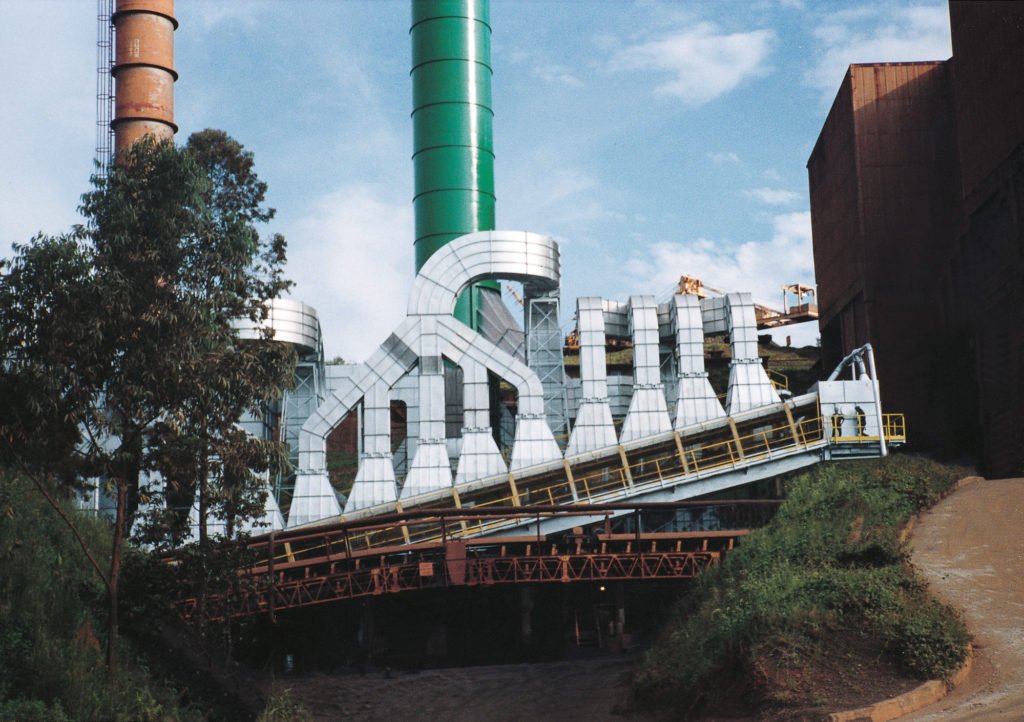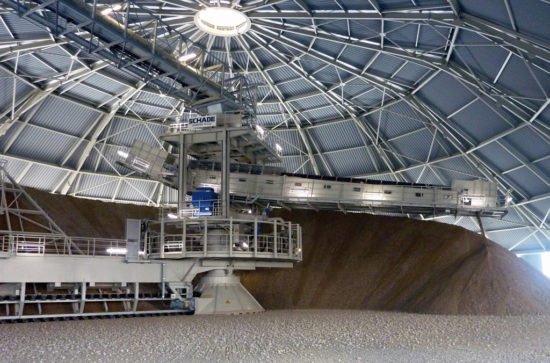AUMUND NEWS 1//2019 – Products. Projects. Progress.
AUMUND Fördertechnik
Modernisation of hot material transport systems.
Millennium Steel, December 2018.

In our daily business we are often focused on the short range outlook – solving today´s problems to get short-term and quick results – so we prefer simple and traditional solutions.
Unfortunately, this can block the view to alternative answers, and what looks good in the short term may be a disadvantage in the long run. Two examples of technological solutions that may fall in this category, illustrating the benefits of tailor-made solutions, are described.
This article written by Frank Reddemannwas published in “Millennium Steel US 2018”, December 2018.
Contact: metallurgy@aumund.de AUMUND Fördertechnik GmbH www.aumund.com
Advantages of AUMUND Pan Conveyors
- Material temperatures up to 800°C and more
- Capacities of 1,500 t/hDistances of more than 100m have been realised
- Robust conveyor design with additional wear protection
- Life-lubricated rollers -no lubrication maintenance needed
Modernisation of hot material transport systems
ln our daily business we are often focused on the short range outlook- solving today’s problems to get short-term and quick results -so we prefer simple and traditional solutions. Unfortunately, this can block the view to alternative answers, and what Iooks good in the short term may bea disadvantage in the long run. Two examples of technological solutions that may fall in thiscategory, illustrating the beneflts of tailor-made solutions, are described.
The current world steel situation, with overcapacity, market turbulence and geopolitical conflicts, is usedby many producers to improve operational procedures and modify or replace equipment This tends to be focused on the main technological equipment, but material flow between the individual process steps has, deservedly, got more attention in recent years in order to optimise the overaII process.
lt is no secret that a Iot of energy and time can be savedby hot charging of materials into furnaces, but the need for transporting hot bulk materials from one stage to the next makes entirely new demands on material transport systems. The interests of a tier-1 plant suppliers and plant operators can be very far apart, so some specific exampleswill be described.
CASE 1: HANDLING OF HOT FE PELLETS
The use of iron ore pellets has become increasingly popular in a variety of metallurgical processes over the last few decades, resulting in the establishment of new pelletising plants and the upgrading of existing ones to meet demand. ln established pellet plants, transport of hot pellets was not part of the original process flow chart; hot pellets were cooled immediately after production then transported via rubber belts for storage or immediate use. As pellet demand increased and plant ouputs increased, problems with cooler capacity began to occur, resulting in higher pellet discharge temperatures. This caused problems with the rubber belt transport systems which were not designed for high temperature transport and so needed increased maintenance, resulting in higher costs and more plant downtime. The initial solution by plant operators was to water-cool the pellets, but pellet quality immediately suffered, so this was not a Solution.
ln addition, with the increased demand for hot charging of pellets (up to 800°(), for instance, to EAFs to reduce energy consumption, the use of rubber belt transportwas simply not an option.

THE SOLUTION: METALLIC PAN CONVEYORS
Modern metallic pan conveyor systems as designed and built by AUMUND provide an immediate technological solution to hotpellet transport and are being installed worldwide (see Figure 7). However, metallic pan conveyors provide a wider range of options than simple transport only. As material temperatures up to 800 °( and more are not a problem, and capacities of l,SOOt/h and distances of more than 1DOm have been realised, this opens up new possibilities for further use of hot pellets in the technological chain.
The hot charging of pellets into EAFs is now well established, however, as cold pellets are also used as feedstock in blast furnaces and in direct reduction plants the opportunity arises for hot charging here, too, and so provides a technical or econornic advantage. Up to now, because using a rubber belt conveyor was not possible, hot charging to these processes has not been investigated in any detail, but there are advantages to be gained by the use of hot pellets.
Another use of metallic pan conveyors is as an additional linear cooler to supplement an under-capacity existing rotary-type cooler. This additional cooling option is not a substitute for a conventional pellet cooler, but it can extend the cooling capacity of existing installations. Cooling conveyors have been supplied by AUMUND to Brazil and lndia for such applications.

CASE 2: HANDLING OF HOT FE SINTER
Mostsinter plants worldwide have been in operation for rnany decades, and many are in a condition such that continued repair and maintenance cannot extend their lifetime for much langer. Thus, fundamental decisions about replacement or conversion aretobe expected in the near future. After visiting rnany plants in Europe, Asia and South America, we realised that there are some key areas which could be addressed by using metallic pan conveyors, and are given below:
- Conveying hotsinter between sinter machine/crusherand cooler could be improved by replacing vibrating conveyors with metallic pan conveyors
- Energy consurnption and noise could be reduced
- The tirne-consuming replacement of worn troughs in vibrating feeders was completely eliminated
Currently, we have metallic pan conveyors in operation for transporting hotsinter in sintering plants in Germany, Austria and the Netherlands. For this application the conveyor type KZB-S has been optimised. After some initial skepticism by operators, these conveyors have been in operation for more than 10 years without any major problems. Hotsinter carrying capacity could also be increased by up to three times.
Sorne specific design features include very robust conveyor design with additional wear protection and the development of life-lubricated rollers, which means no lubrication maintenance is needed.
The latest design of hot sinter conveyor for a Japanese steelmaker, transporting nearly 1,500tlhr, will be commissioned at the end of 2016. Sinter production willalso be optimised with an additional heat recovery system.

CONCLUSIONS
Both the applications described illustrate an unconventional solution to existing plant problems. The use of metallic plate conveyors is a deviation from traditional approaches, but provides an effective technological solution which has the potential to enter other areas within the steel industry to reduce costs or increase process efficiency.
Frank Reddemann is Senior Manager, Metallurgy Division at AUMUND Fördertechnik GmbH, Rheinberg, Germany
Contact
If we can help you with any further information, please use the contact form to get in touch.
You will receive an immediate automated acknowledgement, and we will respond to your enquiry as soon as possible.
Many thanks
AUMUND. SCHADE. SAMSON.






